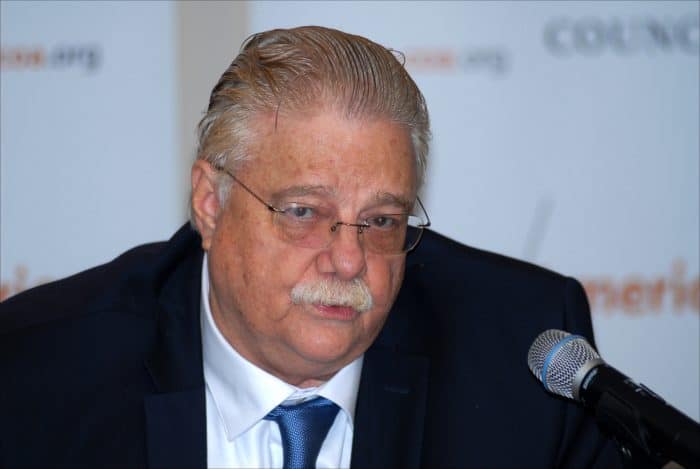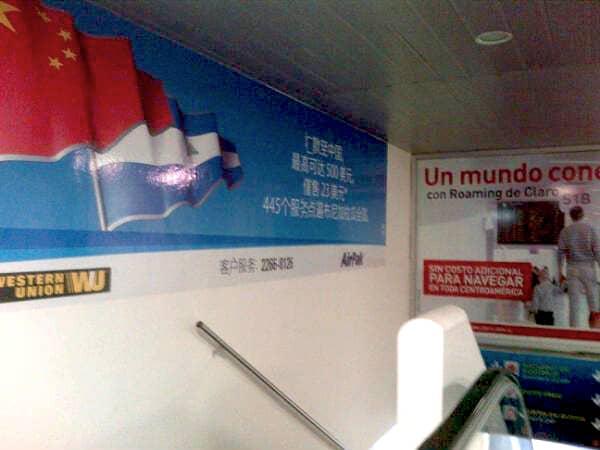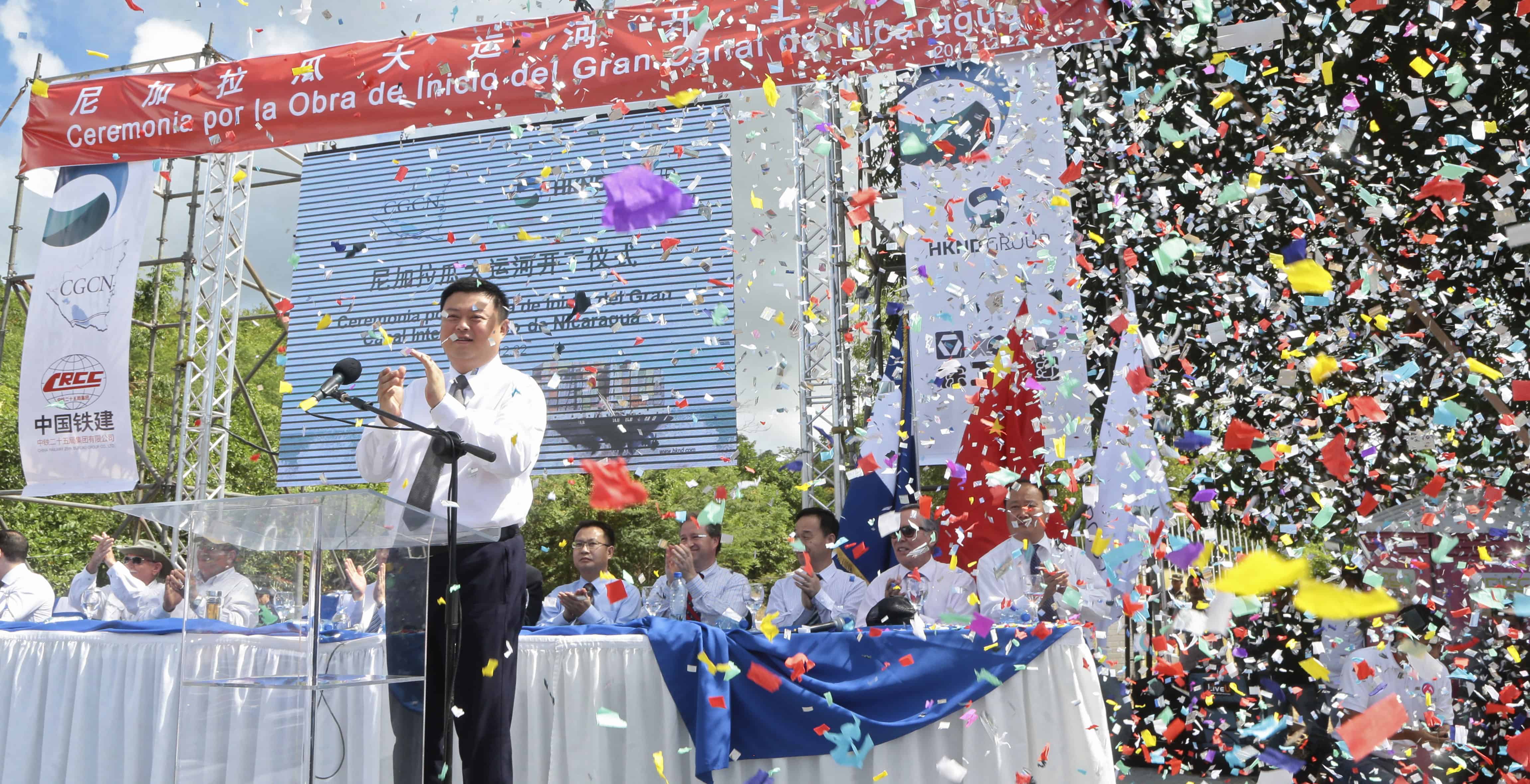WASHINGTON, D.C. – The proposed $50 billion interoceanic Nicaragua Canal – the biggest earthmoving project in world history – will cut poverty in half, double the country’s GDP growth and energize Central American integration by servicing a boom in global shipping that will quickly outgrow even the newly enlarged Panama Canal.
So claims Paul Oquist.
A key adviser to President Daniel Ortega and executive director of the Nicaraguan Canal Commission, Oquist came to Washington last week to drum up support for Ortega’s controversial, Chinese-funded plan to dig a mammoth 275-kilometer-long waterway from the Atlantic to the Pacific.
In a data-filled Sept. 22 presentation to the Washington-based Americas Society/Council of the Americas, he said that under Ortega’s stewardship, foreign direct investment has jumped from $286 million in 2006 – the year before the Sandinista leader took office for a second term – to $1.4 billion in 2014. Foreign reserves now stand at a record $2.3 billion, and foreign external debt is only 40 percent of GDP, down from 109 percent in 2005.
“We’ve cut extreme poverty in half, and we’ll do it again in our lifetime with the canal. But to overcome extreme poverty in our lifetime, we’d have to grow by 10 percent,” Oquist said, noting that Panama – thanks largely to the 100-year-old canal and the maritime industry that’s grown up around it – managed to take its economy from $17 billion in 2007 to $45 billion last year, with GDP this year projected to reach $49 billion in 2015.
Nicaragua, he said, hopes to boost its economy from the current $11.8 billion to $25 billion by the end of this decade, assuming the Nicaragua Canal is built.
“Instead of growing by 4 or 5 percent, we’ll grow 10 to 12 percent. That will mean we can double the formal sector,” he claimed. “This is going to speed up Central American integration more than the ministers of Central America and the Dominican Republic holding another 20 meetings and signing another 20 agreements.”
Oquist added: “Heretofore, people haven’t come to Nicaragua to work. But now, there’ll be a need for professionals and skilled- and medium-level technicians. Construction is very democratic. There will be work for everyone. There’s nothing afloat today on the high seas that will not be able to go through that canal.”

World commerce in 2030
The speech by Oquist, who was introduced by Francisco Campbell Hooker, Nicaragua’s ambassador to the United States, was the first time any Nicaraguan official has spoken publicly about the project – which involves moving five billion cubic meters of dirt.
Yet the negotiations behind the canal have also been cloaked in secrecy, leading to widespread skepticism.
Related: US concerns grow over possible Nicaragua Canal land expropriation, ambassador says
Detractors say the proposed canal will devastate the environment by creating a “dead zone” in Lake Nicaragua, while uprooting thousands of indigenous people from their land and opening the door to massive corruption. Police have already broken up several anti-canal demonstrations, often using violence against protesters.
According to documents already released by Oquist’s office of the proposed canal’s 275-kilometer length, 106 kilometers will pass through Lake Nicaragua, and another 39.5 kilometers through an artificial lake to be created by damming the Río Punta Gorda. The canal will be 30 meters above sea level – which is the level of Lake Nicaragua – and a series of locks will raise and lower vessels in increments of 10 meters each.
This is the same technology employed by the Panama Canal, but the locks in Nicaragua’s canal will be considerably bigger, said Oquist: 525 meters long compared to Panama’s 427 meters, and 75 meters wide compared to Panama’s 55 meters, with a draft of 27.6 meters (as opposed to 18.3 meters for Panama).
“The Panamanians haven’t built a larger lock because they don’t have the water to handle the dimensions,” he said. In early August, a drought caused by the El Niño weather system temporarily forced the Panama Canal Authority to reduce the canal’s draft due to lower water levels.
Upon completion of the Panama Canal’s current expansion program, said Oquist, the waterway will be able to handle ships with capacities of up to 13,000 TEUs (20-foot-equivalent units). But the largest ships at sea already carry 19,200 TEUs, with even bigger vessels on order at South Korean shipyards.
“The Nicaraguan locks will be able to handle 25,000 TEUs, leaving a margin of 5,000 TEUs for the future,” he said, quoting from a U.S. Army Corps of Engineers study predicting that these new post-Panamax megaships will be carrying 60 to 70 percent of world commerce by 2030.
“Globalization will continue to increase the metric tonnage and value of external commerce, as well as the size of the ships, from 800 TEUs in the 1950s to 20,000 today. This is a geometrical expansion,” he said, adding that since 2008, the shipping industry has lost $9 billion.
“The only companies making money are those that have larger, more fuel-efficient ships,” he said, noting that Nicaragua’s proposed canal would cut two weeks off the Norfolk-Shanghai route – since megaships now on the order book won’t fit through the enlarged Panama Canal and would have to sail around the Straits of Magellan.
“That means ships can make only nine trips a year without the canal. With the canal, they can make 12 trips a year. The reason this transition to larger ships will take place is economic. It represents a 50 percent reduction in CO2 emissions, and a 30 percent reduction in the cost of transport. This will be the driver of this transition. It has major economic repercussions, as the financing of this canal, because a lot of companies can invest in the canal and get their money back long before they sniff the first dividend.”
In addition to the canal itself, the Chinese also plan to build a free zone on the Pacific side that will employ 113,000 factory workers – as well as an international airport capable of receiving jumbo jets, and 582 kilometers of roads and highways. A planned bridge spanning the canal will be 80 meters high, compared to the Puente de las Américas over the Panama Canal, which has a clearance of 60.3 meters.
The winner of the 50-year Nicaragua Canal concession, Hong Kong-based HKND Group, will oversee the canal as a build-operate-transfer project, though exactly how it intends to finance it remains a mystery.

Reverse migration?
Building the canal itself will require 50,000 workers, including 12,500 Chinese laborers, under terms of the contract.
“We have a deal with HKND that preference will be given to Nicaraguan workers. Half the construction workers will be Nicaraguans,” said Oquist. “This leads to our No. 1 challenge right now: educating and training the Nicaraguan people to be able to assume these roles. We hope a lot of Nicaraguans will come home now that they can get a good job and reunite their families.”
He insisted that “lots of misinformation is in the air” about the project, especially as it relates to the relocation of indigenous people along the proposed canal route. No more than 28,000 campesinos – or 7,100 families – will be moved, not 100,000 people as claimed by several European NGOs, which Oquist did not identify.
“After the master concession was signed with HKND, it went to the South Atlantic Autonomous Region and was unanimously approved by their assembly. The route had not been chosen yet,” he said. After that, the National Congress approved the project, which was rapidly introduced into the Nicaraguan Constitution.
“The six proposed routes were whittled down to one route, which was chosen not because it was the least expensive, but because it had the lowest environmental and social impact,” said Oquist. “Our plan is that no one will be moved more than 12 kilometers, so as to maintain family structures.”
Wang Jing, the billionaire telecom tycoon who runs HKND Group, has vowed to complete the project by 2020. However, a story published by The Guardian on Friday noted that China’s recent stock market crisis has “wiped out nearly 85 percent” of Wang’s fortune. “Analysts said Wang’s dismal fortunes – Bloomberg called him the world’s worst performing billionaire in 2015 – could affect the ability of his company, HKND, to push ahead with construction of the 178-mile canal in Nicaragua,” The Guardian wrote.






